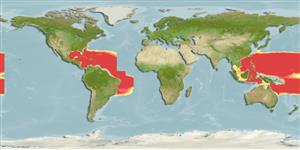>
Trachichthyiformes (Roughies) >
Anoplogastridae (Fangtooths)
Etymology: Anoplogaster: Greek, ana = up + Greek, oplon = shield + Greek, gaster = stomach (Ref. 45335); brachycera: From the main characters of the young specimens which have short temporal and pre-opercular spines..
Environment: milieu / climate zone / depth range / distribution range
Ekologi
laut batipelagis; kisaran kedalaman 0 - 1500 m (Ref. 31253). Deep-water
Pacific and Atlantic: tropical waters, from the Sulu Sea in the western Pacific and from the Gulf of Mexico to north of the Bahamas Islands in the western Atlantic (Ref. 50735); off southeastern USA (Moore, pers. comm.).
Size / Weight / umur
Maturity: Lm ? range ? - ? cm
Max length : 6.0 cm SL jantan/; (Ref. 31253)
Minimum depth from Ref. 58018.
Life cycle and mating behavior
Kematangan | Reproduksi, perkembang biakan | Pemijahan | telur-telur | Fecundity | Larva
Paxton, J.R., 1999. Order Beryciformes. Anoplogastridae. Fangtooths. p. 2210. In K.E. Carpenter and V.H. Niem (eds.) FAO species identification guide for fishery purposes. The living marine resources of the WCP. Vol. 4. Bony fishes part 2 (Mugilidae to Carangidae). FAO, Rome. (Ref. 9852)
Status IUCN Red List (Ref. 130435)
ancaman kepada manusia
Harmless
penggunaan manusia
Perikanan: tidak ada kepentingan
informasi lanjut
Nama-nama umumSinonim (persamaan)metabolismePemangsaEkotoksikologiReproduksi, perkembang biakanKematanganPemijahanSpawning aggregationFecunditytelur-telurpekembangan telor
Umur / Saiz
Pertumbuhan
panjang-berat
panjang-panjang
ukuran frekuensi
Morfometrik
Morfologi
Larva
Dinamika larva
pemulihan
Kelimpahan
BRUVS
AcuanBudidaya airprofil budidaya airStrainGenetikaElectrophoresesDiturunkanPenyakit-penyakitPengolahanNutrientsMass conversion
mitraGambarStamps, Coins Misc.Suara-suaraCiguateraKecepatanTipe renangArea insangOtolithsOtakPenglihatan / visi
Alat, peralatan
laporan khas
muat turun XML
Sumber internet
Estimates based on models
Preferred temperature (Ref.
123201): 7.2 - 18.9, mean 11.1 °C (based on 563 cells).
Phylogenetic diversity index (Ref.
82804): PD
50 = 1.0000 [Uniqueness, from 0.5 = low to 2.0 = high].
Bayesian length-weight: a=0.01995 (0.00906 - 0.04395), b=3.01 (2.83 - 3.19), in cm total length, based on all LWR estimates for this body shape (Ref.
93245).
Trophic level (Ref.
69278): 3.3 ±0.5 se; based on size and trophs of closest relatives
Fishing Vulnerability (Ref.
59153): Low vulnerability (10 of 100).
